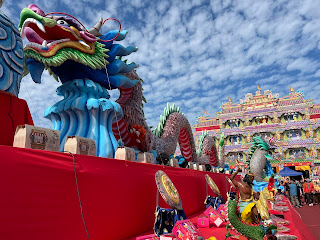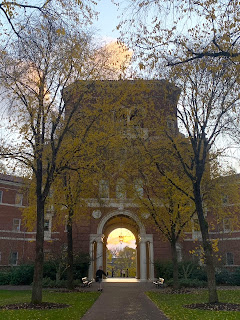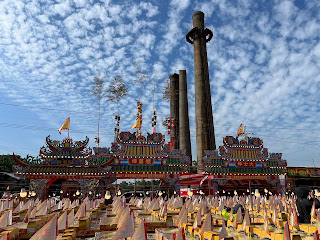Fog or smog? Most of the time it's obviously the latter (though the skies of the Chinese capital have been remarkably clear recently), but one morning in mid-November stood out as being more foggy than polluted. That said, the AQI was still above 120 that day:
With home being only the two of us these days (not including the cat), the wife and I decided to forgo preparing a large turkey meal for Thanksgiving. The embassy cafeteria did its best to compensate in the runup to the holiday:
Some recently installed public art along the Liangma River 亮马河 near our residential community:
Shu-E takes it all in. She isn't a lover of modern art:
If you are looking for a last-minute stocking stuffer this Christmas, it is tempting to turn to the self-help section of the bookshop — perhaps the increasing number of tomes claiming to impart ancient pearls of Japanese wisdom.
In the past decade, such books have proliferated, claiming to teach you the Japanese secret to everything — eat less, save money, be more productive. Ikigai 生き甲斐, wabi-sabi わび・さび or shinrin yoku 森林浴 will fix what is wrong with your life.
They tend to follow a similar pattern: A word you might not be familiar with at first, with a title that hints at hidden knowledge, the idea that the Japanese are tapped into some timeworn understanding about things modern Western society — too rushed, too online, too whatever — has forgotten.
The growth has matched increasing global interest and travel to the nation. Talking to first-time tourists or perusing online forums, I often find astonishment: Why does everything work so well? How else could public safety and famed attention to detail be sustained, if not from some secret knowledge the West has lost?
Do not get me wrong, there are many things to be learned from Japan, but for the most part, it does not come in the form of trite life hacks.
A Western obsession with so-called Oriental wisdom is nothing new: From The Book of Tea in 1906 to the post-World War II interest in Zen Buddhism 禅宗, it has long been assumed that the east is home to deep knowledge.
It is not just confined to self-help — 1980s Americans became obsessed with Japanese productivity techniques such as kaizen 改善 to understand how their companies could possibly beat US ones — but the current fad for such techniques might be traced to Marie Kondō’s 近藤麻理恵 2010 book The Life-Changing Magic of Tidying Up: The Japanese Art of Decluttering and Organizing.
Kondo promises to lift the veil on the secrets to the life we all want. While it lacks a mysterious foreign word in the title, it has everything else. As the writer Matt Alt notes, the English translation turns decluttering from mere housework to “an Art, with a capital A, echoing austere pastimes such as inkbrush-painting or the tea ceremony,” but there is no art form here; indeed, the irony is that a typical Japanese house is often extremely cluttered, which is why her KonMari こんまり method took off at home first. (Kondo herself gave up on the idea pretty quickly when she had children.)
If KonMari and her subsequent Netflix show lit the spark, what really fanned the flame was the concept of ikigai.
The word describes a “reason for living” and was popularized by the 2016 book Ikigai: The Japanese Secret to a Long and Happy Life by Hector Garcia and Francesc Miralles. It was the right concept at the right time, with smartphones and social media increasingly frazzling our minds. Dozens of other books claiming the secrets followed, asking how older people in Okinawan 沖縄 villages live such happy and long lives. The government itself has leaned in.
That has spawned a series of publications turning everyday, universal concepts into pseudo-intellectual Oriental tosh.
“Ganbatte 頑張って is a Japanese philosophy focused on doing the best you can with what you have,” says one (it is just a word meaning to do your best.) How about hara hachibu 腹八分 — eating until you are 80 percent full, or put more simply, not stuffing your face. Going for a walk in nature becomes the classical practice of shinrin yoku, or forest bathing, and though there are scientifically proven benefits to spending time in greenery, the Japanese cannot claim to have invented it.
Tracking your expenses by writing them down in a notebook, something my decidedly Irish father has done for decades, becomes kakeibo 家計簿. How about gaman 我慢, the art of putting up with things — because, of course, this nation is the only place where people do this. Even that stack of books you bought, but have not read is in fact a time-honored technique: tsundoku 積読, the practice of letting texts pile up and somehow absorbing them by osmosis.
These days, I increasingly see these “techniques” on social media, where engagement farmers masquerading as thought leaders turn them into artificial intelligence-generated slop. Here are three different accounts posting the same “eye-opening Japanese techniques to overcome laziness,” garnering a combined 5 million views — but amusingly, they feature the technique of pomodoro, perhaps a Japanese-sounding word that is in fact Italian for tomato.
Even Elon Musk periodically posts about wabi-sabi, but what he means by it no one can say, likely including Musk himself.
We should certainly think about how to live more meaningful, purposeful lives, but is ikigai really the reason people in Japan get up in the morning, as some proclaim? For me, the reason is I want to keep my job and I think that is true for many in the nation who, for the most part, live ordinary lives.
Yes, there is much to learn from what is an extremely functional, high-trust society. It can provide insight into how some older people stay happy and healthy, but imbuing prosaic words with special knowledge and hallowed wisdom reduces insight to lazy stereotypes and tropes.
Much of what makes Japan work has more to do with mundane public policy solutions, education and social standards, rather than some secret self-help tip. Yet there appear few who want to learn how the nation dealt with economic decline while maintaining law and order, or how it managed COVID-19 without lockdowns.
Articles on Okinawa rarely note that the prefecture, in addition to the longest lifespan, also has one of the highest rates of alcohol consumption in the nation. No one is arguing that is the secret to getting up in the morning.
Do people live so long because of ikigai, or is it because of diet and portion sizes, mandated annual checkups and universal access to healthcare? Are people content because of an appreciation of wabi-sabi or because housing is cheap, unemployment is low and quality food is plentiful?
Sensible zoning techniques and healthcare funding cannot be wrapped up in a snappy catchphrase, but likely have much more to do with actual outcomes. It often seems people will learn anything from Japan except actual practical policy fixes, but the nation is not a repository of mystical hidden knowledge. So this Christmas, I suggest practicing the Japanese art of mou ee deshou もういいでしょう — give it a rest.


















































No comments:
Post a Comment